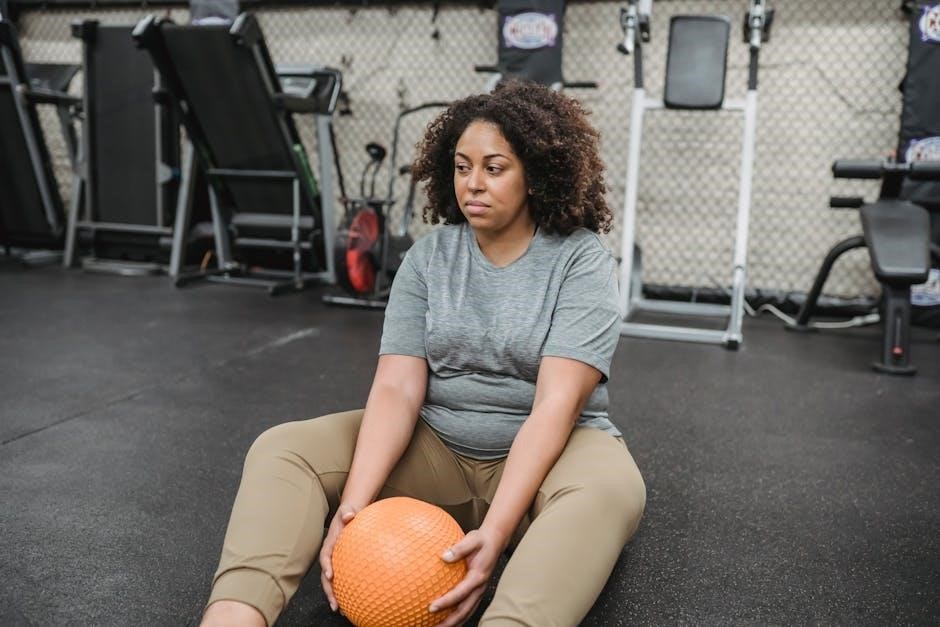Functional strength training focuses on movements that enhance daily activities and sports performance, promoting a holistic approach to fitness. It improves coordination, balance, and overall physical resilience, making it adaptable for various goals and fitness levels.
What is Functional Strength Training?
Functional strength training (FST) is a fitness approach focusing on exercises that mimic real-world movements, enhancing mobility, stability, and resilience. It targets muscle groups used in daily life or sports, improving coordination and reducing injury risk. FST combines compound movements like squats and deadlifts with isolation exercises to build balanced strength. Programs often include progressive overload, ensuring continuous improvement. This training is adaptable to all fitness levels, making it a versatile option for achieving specific goals, whether for sports performance or everyday functionality.
Importance of Functional Training for Daily Activities
Functional strength training bridges the gap between gym workouts and real-life tasks, enhancing the ability to perform daily activities with efficiency and safety. By improving strength, balance, and coordination, it helps individuals carry groceries, play with children, or climb stairs with greater ease. This approach reduces the risk of injuries during everyday movements and boosts overall physical resilience, making it indispensable for maintaining independence and quality of life as people age or pursue active lifestyles.
Benefits of a Functional Strength Program
Functional strength programs enhance physical resilience, improving coordination, balance, and overall fitness. They prepare the body for real-world challenges, boosting efficiency in daily tasks and sports performance.
Improved Functional Fitness and Coordination
Functional strength training enhances coordination by focusing on balanced muscle development and real-world movement patterns. It improves flexibility, stability, and overall physical efficiency, making daily activities easier. Programs often include balance drills, core exercises, and dynamic movements that strengthen functional fitness. This holistic approach ensures better posture, reduced injury risk, and improved athletic performance. By mimicking real-life actions, functional training boosts coordination, making it ideal for both general fitness and sport-specific goals. Progress is tracked through improved task execution and reduced fatigue.
Injury Prevention and Rehabilitation
Functional strength training is a cornerstone of injury prevention and rehabilitation. By focusing on balanced muscle development and real-world movement patterns, it strengthens stabilizer muscles, improves joint stability, and enhances neuromuscular control. This reduces the risk of injuries and accelerates recovery. Programs often include exercises targeting specific weaknesses, such as core work and balance drills, to restore proper movement patterns. Functional training also builds resilience, helping individuals return to daily activities or sports with improved strength and confidence, minimizing the likelihood of future injuries.
Enhanced Athletic Performance
Functional strength training is highly effective for enhancing athletic performance by improving power, speed, and endurance. It focuses on exercises that mimic sport-specific movements, allowing athletes to perform more efficiently. Programs often integrate high-intensity interval training (HIIT) and bodyweight exercises to boost energy levels and muscular endurance. This approach strengthens key muscle groups, enhances coordination, and optimizes movement patterns, enabling athletes to excel in their respective sports with greater precision and overall performance capabilities.
Key Principles of Functional Strength Training
Functional strength training emphasizes balanced muscle development, real-world movement patterns, and progressive overload. It focuses on exercises that mimic daily tasks and sports, ensuring practical strength gains.
Balanced Muscle Development
Balanced muscle development ensures no muscle group is over- or underdeveloped, enhancing overall functionality and reducing injury risk. It involves targeting all major muscle groups with compound exercises like deadlifts and squats. This approach improves coordination, posture, and movement efficiency, ensuring muscles work synergistically. Avoiding muscle imbalances is crucial for optimal performance in both daily activities and sports. A well-rounded program promotes symmetry, strength, and mobility, laying the foundation for long-term functional fitness and athletic success.
Focus on Real-World Movement Patterns
Functional strength training emphasizes movements that mimic real-life activities and sports, ensuring practical application of strength. Exercises like squats, lunges, and step-ups improve coordination and efficiency in daily tasks. This approach bridges the gap between gym training and real-world demands, enhancing performance in activities requiring stability, mobility, and power. By replicating natural movement patterns, individuals build functional fitness that directly translates to better execution of everyday tasks and athletic endeavors, making workouts more purposeful and effective; This method ensures lasting benefits beyond traditional strength training.

Structure of a Functional Strength Program
A functional strength program typically includes structured phases, such as foundation, strength, and power, with a weekly schedule of 4-6 workouts, allowing for progression and adaptation.
Phases of Training (e.g., Foundation, Strength, Power)
A functional strength program is typically divided into phases: foundation, strength, and power. The foundation phase builds basic strength and mobility, while the strength phase focuses on progressive overload. The power phase emphasizes explosive movements and speed. Each phase is designed to gradually increase intensity, ensuring adaptation and reducing injury risk. Programs like the RCMP’s four-level training or an eight-week functional rebuild exemplify these structured approaches, adapting to individual fitness levels and specific goals.
Weekly Workout Schedule and Volume
A functional strength program typically includes 4-6 workouts per week, with 1-2 rest days. Programs like the RCMP’s four-level training or an 8-week functional rebuild offer structured schedules. Some programs follow a three-days-on, three-days-off format, while others include up to 5 training days. Weekly volume varies, with 10-11 exercises per session, focusing on functional movements and progressive overload. Adjustments in exercise difficulty ensure the program remains challenging and adaptable to individual fitness levels and goals.
Essential Exercises for Functional Strength
Compound movements like deadlifts and squats are foundational, while functional isolation exercises such as core work and balance drills enhance real-world movement and muscle balance.
Compound Movements (e.g., Deadlifts, Squats)
Compound movements like deadlifts and squats are cornerstone exercises in functional strength training. They engage multiple muscle groups simultaneously, improving coordination, strength, and real-world functionality. Deadlifts enhance posterior chain strength, while squats build leg and core stability. These exercises are versatile, with variations like weighted squats or Romanian deadlifts to target specific muscle groups. Incorporating compound movements ensures balanced development and prepares the body for everyday tasks and athletic demands, making them indispensable in any functional training program.
Functional Isolation Exercises (e.g., Core Work, Balance Drills)
Functional isolation exercises, such as core work and balance drills, target specific muscle groups to enhance stability, posture, and overall functional movement. Core exercises like planks and Russian twists improve trunk stability, while balance drills refine coordination and proprioception. These exercises are essential for addressing muscle imbalances and preventing injuries, ensuring a strong foundation for more complex movements in a functional strength training program.
Progression and Variation in Training
Progression and variation in training ensure continued improvement by adjusting intensity, volume, or exercises. This approach prevents plateaus and keeps workouts engaging, promoting long-term success.
Overload Techniques (Weight, Reps, Sets)
Overload techniques, such as increasing weight, reps, or sets, are essential for progressive muscle growth and functional strength. Gradually adding intensity challenges muscles, enhancing endurance and power. These methods prevent plateaus, ensuring continuous improvement in strength and performance. They are integral to structured programs, allowing individuals to tailor their training to specific goals, whether for sports or daily activities, ensuring a well-rounded and effective approach to functional strength development.
Variation in Exercises and Programs
Variation in exercises and programs keeps workouts engaging and prevents plateaus. Incorporating diverse movements ensures well-rounded muscle development and functional improvement. Periodically changing routines targets different muscle groups, enhancing overall fitness. This approach also caters to varying fitness levels and goals, ensuring a personalized and adaptable training experience. Regular exercise variation promotes long-term progress, making it easier to maintain motivation and achieve real-world functionality, whether for sports or everyday activities.
Role of Conditioning in Functional Training
Conditioning is crucial for building endurance and stamina, bridging strength with real-world functionality and enhancing overall athleticism for daily tasks and sports performance effectively.
High-Intensity Interval Training (HIIT)
HIIT combines short bursts of intense exercise with brief recovery periods, enhancing cardiovascular fitness and muscular endurance. It’s a time-efficient way to improve performance, boosting both aerobic and anaerobic capacities. Often integrated into functional strength programs, HIIT accelerates fat loss and increases metabolic rate. Programs like the 6-week functional bodybuilding plan use HIIT to transform physiques and enhance athleticism. This method is ideal for those seeking real-world application of strength and endurance, making it a cornerstone in modern functional training routines for all fitness levels.
Endurance and Stamina Development
Functional strength programs often incorporate endurance training to build sustained energy levels and prolong activity capacity. Structured workouts, such as 12-week endurance plans, combine strength exercises with cardiovascular drills to enhance stamina. This approach supports both daily tasks and athletic performance, ensuring long-term physical resilience. Programs like the 4-week functional strength plan emphasize progressive overload to gradually improve endurance, making it a vital component for overall fitness and real-world application of strength and conditioning. This balanced method ensures comprehensive physical development.

Nutrition and Recovery for Functional Training
Proper nutrition and recovery are essential for muscle repair and energy replenishment in functional training, ensuring optimal performance and progress.
Nutritional Support for Muscle Growth and Repair
A well-balanced diet is crucial for muscle growth and repair in functional training. Emphasize protein-rich foods to promote muscle synthesis, alongside complex carbohydrates for energy. Adequate hydration and essential nutrients like vitamins and minerals support recovery. Timing meals around workouts can enhance performance and recovery, while avoiding excessive processed foods ensures optimal results. A structured nutrition plan complements training, fostering strength and endurance gains.
Recovery Techniques (e.g., Stretching, Foam Rolling)
Recovery techniques like stretching and foam rolling are essential for muscle repair and flexibility after functional training. Stretching improves range of motion, while foam rolling reduces muscle tension and enhances blood flow. These practices aid in injury prevention and promote faster recovery. Incorporating them into your routine ensures sustained progress and overall well-being. Consistency in recovery techniques complements training, allowing the body to adapt and perform at its best.
Measuring Progress in Functional Training
Track strength improvements and functional abilities to assess progress. Regularly monitor performance in exercises and daily activities to ensure consistent growth and adaptation over time.
Tracking Strength Gains
Tracking strength gains involves monitoring progress through specific exercises, weight lifted, and repetitions completed. Programs like the RCMP Functional Strength & Conditioning Program offer structured assessments to evaluate improvements. Regularly measuring performance in deadlifts, squats, and other compound movements ensures consistent growth. Over time, these metrics demonstrate increased strength and functional ability, aligning with overall fitness goals and enhancing daily activities or sports performance.
Assessing Functional Improvement
Assessing functional improvement involves evaluating how well strength training translates to real-world movements and daily activities. Programs like the RCMP Functional Strength & Conditioning Program include assessments to measure progress in balance, coordination, and overall physical resilience. By tracking improvements in exercises such as deadlifts and squats, individuals can identify areas of growth and address imbalances, ensuring their training aligns with functional goals and enhances both daily life and sports performance.
Safety and Injury Prevention
Functional strength training emphasizes proper warm-ups, form, and technique to minimize injury risks. Structured programs with gradual progression ensure safe and effective participation, reducing overtraining and enhancing resilience.
Warm-Up and Cool-Down Routines
A proper warm-up prepares the body for exercise, increasing blood flow and flexibility, while a cool-down aids recovery. Functional strength programs often include dynamic stretching and mobility exercises to prevent injuries and improve range of motion. Incorporating these routines ensures safer workouts and enhances overall performance, aligning with the principles of gradual progression and injury prevention emphasized in functional training programs.
Importance of Proper Form and Technique
Proper form and technique are crucial in functional strength training to prevent injuries and ensure effective muscle engagement. They optimize performance, enhance functional fitness, and align with program principles. Correct execution promotes balanced muscle development and real-world movement patterns, reducing the risk of overuse injuries. Prioritizing technique fosters long-term progress and maintains the integrity of exercises, making workouts safer and more efficient for all fitness levels.

Mind-Body Connection in Functional Training
Functional training emphasizes the mind-body connection, fostering focus and mental resilience. It enhances concentration, discipline, and physical execution, ensuring consistent progress and overall fitness development.
Focus and Concentration During Workouts
Focus and concentration are critical in functional strength training, ensuring proper form and technique. A goal-oriented mindset enhances exercise execution, reduces injury risk, and boosts overall performance. Maintaining concentration helps athletes stay motivated, fostering mental discipline and resilience. This mental engagement is vital for maximizing results and achieving long-term fitness goals, as highlighted in programs like the RCMP Functional Strength Program and other structured training guides.
Mental Resilience and Discipline
Mental resilience and discipline are cornerstone traits for success in functional strength training. Consistency in following structured programs, like the RCMP Functional Strength Program, requires dedication and focus. Overcoming challenges and maintaining motivation during rigorous workouts build mental fortitude. Discipline ensures adherence to training schedules and progressive overload, fostering long-term physical and mental growth. These qualities are essential for achieving peak performance and sustaining a commitment to functional strength training. They empower individuals to push through barriers and embrace continuous improvement.
Customizing the Program for Individual Needs
Customizing functional strength programs ensures they meet individual fitness levels and goals, whether weight loss, sport performance, or overall wellness, making training more effective and personalized.
Adjusting for Different Fitness Levels
Functional strength programs can be tailored to suit various fitness levels, ensuring safe and effective progress. Beginners may start with bodyweight exercises, while advanced individuals incorporate resistance or complex movements. The RCMP program, for example, offers four levels, progressing from foundational to advanced training. Adjustments include modifying reps, sets, or intensity to match individual capabilities, ensuring the program remains challenging yet achievable, promoting consistent improvement without risk of injury or burnout.
Tailoring for Specific Goals (e.g., Weight Loss, Sport Performance)
A functional strength program can be customized to meet specific objectives. For weight loss, focus on circuit training and HIIT to maximize calorie burn. Athletes can target sport-specific movements to enhance performance. Programs like the 8-week functional strength plan or 6-week HIIT-bodybuilding hybrid adapt to goals, ensuring exercises align with desired outcomes. This tailored approach optimizes results, whether for aesthetics, endurance, or sport-specific success, making functional training versatile and goal-oriented.
Functional strength training offers a structured, adaptable approach to improving fitness. Programs like the RCMP’s 4-level system or 8-week plans provide clear progression paths. Consistency and proper guidance are key to achieving lasting results, making functional training a valuable investment in long-term health and performance.
Functional strength training programs emphasize real-world movements, improving daily functionality and athletic performance. Structured plans like the RCMP’s 4-level system or 8-week programs guide progressive development. These programs often combine compound movements, isolation exercises, and conditioning, offering adaptability for different fitness levels and goals. Consistency, proper form, and tailored approaches are crucial for maximizing benefits, ensuring sustainable growth in strength, coordination, and overall physical resilience.
Encouragement for Consistent Implementation
Consistency is key to unlocking the full potential of functional strength training. By following structured programs like the RCMP’s 4-level system or 8-week plans, individuals can progressively build strength and functionality. These programs are adaptable to all fitness levels, ensuring steady progress. Stay committed, and you’ll notice improvements in coordination, resilience, and daily performance; Embrace the journey, and the transformative benefits of functional training will empower you to reach your goals effectively and sustainably.

Additional Resources
Explore downloadable PDF templates and guides offering structured workout plans and tracking tools to enhance your functional strength training journey effectively and efficiently.
Recommended Reading and Guides
Explore comprehensive guides like the RCMP Functional Strength & Conditioning Program and Functional Training for Sports. These resources offer detailed workout plans, balance exercises, and progression techniques. Downloadable PDFs such as the 12-Week Endurance Training Program and Functional Hypertrophy Program provide structured approaches for strength, power, and real-world movement enhancement. These materials cater to diverse fitness levels, ensuring a tailored path to improved functionality and performance.
Downloadable PDF Templates and Worksheets
Access customizable PDF templates and worksheets to track your functional strength training progress. Download resources like the RCMP Functional Strength Program or the 12-Week Endurance Training guide. These tools offer structured workout plans, balance exercises, and progression techniques. Whether you’re aiming for hypertrophy or endurance, these free PDFs provide adaptable frameworks for all fitness levels, ensuring consistent improvement and goal achievement in your functional strength journey.

